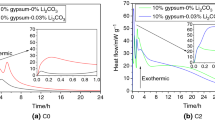Abstract
In polymer modified cementitious materials, it is hard to set up a chemical connection between the added polymer and the cement moiety. In this study FS (functional silane) was adopted to form this connection as a bridge component which has the functional group forming bonds with polymer. To testify the connection between FS and cement moiety, Q 2/Q 1 ratio (Q x: intensity ratio) investigation was carried out by the means of quantitative solid state 29Si MAS NMR. The results show that the Q 2/Q 1 ratio has increased with the addition of FS which indicates that the silicon chain length has increased, and the quantity of silicon atoms at site of Q 2, chain site, has enhanced, showing that the silicon atom of FS has connected to the silicon chain of cement moiety by the bond “-Si-O-Si-” formation.
Similar content being viewed by others
References
M U K Afridi, Y Ohama, K Demura, et al. Development of Polymer Films by the Coalescence of Polymer Particles in Powdered and Aqueous Polymer-modified Mortars[J].Cement and Concrete Research, 2003, 33(11): 1 715–1 721
M U K Afridi, Y Ohama, M Z Iqbal, et al. Water Retention and Adhesion of Powdered and Aqueous Polymer-modified Mortars[J]. Cement and Concrete Composites, 1995, 17(2): 113–118
L K Aggarwal, P C Thapliyal, S R Karade. Properties of Polymermodified Mortars Using Epoxy and Acrylic Emulsions[J]. Construction and Building Materials, 2007, 21(2): 379–383
E -H Hwang, Y S Ko. Effect of Polymer Cement Modifiers on Mechanical and Physical Properties of Polymer-modified Mortar Using Recycled Artificial Marble Waste Fine Aggregate[J]. Journal of Industrial and Engineering Chemistry, 2008, 14(2): 644–650
S -H Hyun, J H Yeon. Strength Development Characteristics of UPMMA Based Polymer Concrete with Different Curing Temperature[J]. Construction and Building Materials, 2012, 37: 387–397
A Jenni, L Holzer, R Zurbriggen, et al. Influence of Polymers on Microstructure and Adhesive Strength of Cementitious Tile Adhesive Mortars[J]. Cement and Concrete Research, 2005, 35(1): 35–50
N Ukrainczyk, A Rogina. Styrene-butadiene Latex Modified Calcium Aluminate Cement Mortar [J].Cement and Concrete Composites, 2013, 41:16–23
J Wang, S Zhang, H Yu, et al. Study of Cement Mortars Modified by Emulsifier-free Latexes[J]. Cement and Concrete Composites, 2005, 27(9–10): 920–925
J J Beaudoin, L Raki, R Alizadeh. A 29Si MAS NMR Study of Modified C-S-H Nanostructures[J]. Cement and Concrete Composites, 2009, 31(8): 585–590
P M Carmona-Quiroga, S Martínez-Ramírez, I Sobrados, et al. Interaction between Two Anti-graffiti Treatments and Cement Mortar (Paste)[J]. Cement and Concrete Research, 2010, 40(5): 723–730
A M Olaru, O Weichold, A Adams. The Hydration of Reactive Cement-in-polymer Dispersions Studied by Nuclear Magnetic Resonance[J]. Cement and Concrete Research, 2011, 41(11): 1 123–1 129
H Hilbig, F H Köhler, P Schiel. Quantitative 29Si MNS NMR Specstroscopy of Cement and Silica Fume Containing Paramagnetic Impurities[J]. Cement and Concrete Research, 2006, 36: 326–329
S L Poulsen, V Kocaba, G Le Saoût, et al. Improved Quantification of Alite and Belite in Anhydrous Portland Cements by 29Si MAS NMR: Effects of Paramagnetic Ions[J]. Solid State Nuclear Magnetic Resonance, 2009, 36(2):32–44
J Skibsted, S Rasmussen, D Herfort, et al. 29Si Cross-polarization Magic-angle Spinning NMR Spectroscopy-an Efficient Tool for Quantification of Thaumasite in Cement-based Materials[J].Cement and Concrete Composites, 2003, 25(8): 823–829
J Rottstegge, M Wilhelm, H W Spiess. Solid State NMR Investigations on the Role of Organic Admixtures on the Hydration of Cement Pastes[J]. Cement and Concrete Composites, 2006, 28(5):417–426
M D Andersen, H J Jakobsen, J Skibsted. Characterization of White Portland Cement Hydration and the C-S-H Structure in the Presence of Sodium Aluminate by 27Al and 29Si MAS NMR Spectroscopy[J]. Cement and Concrete Research, 2004, 34(5): 857–868
S R Davis, A R Brough, A Atkinson. Formation of Silica/Epoxy Hybrid Network Polymers[J]. Journal of Non-Crystalline Solids, 2003, 315(1–2): 197–205
J Schneider, M A Cincotto, H Panepucci. 29Si and 27Al High-resolution NMR Characterization of Calcium Silicate Hydrate Phases in Activated Blast-furnace Slag Pastes[J]. Cement and Concrete Research, 2001, 31(7): 993–1 001
I G Richardson. The Calcium Silicate Hydrates[J]. Cement and Concrete Research, 2008, 38(2): 137–158
Author information
Authors and Affiliations
Corresponding author
Additional information
Funded by the National Basic Research Program of China (973 Program(No.2009CB6232007)
Rights and permissions
About this article
Cite this article
Zhu, J., Li, Z., Yang, R. et al. Organic additive implantation onto cement hydration products. J. Wuhan Univ. Technol.-Mat. Sci. Edit. 29, 527–533 (2014). https://doi.org/10.1007/s11595-014-0952-1
Received:
Accepted:
Published:
Issue Date:
DOI: https://doi.org/10.1007/s11595-014-0952-1




